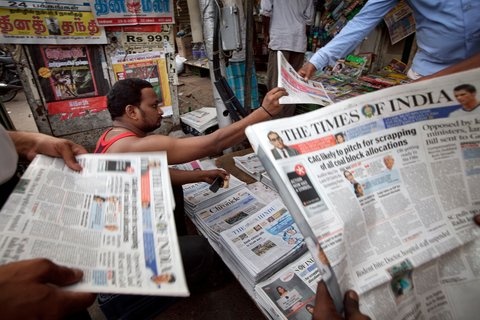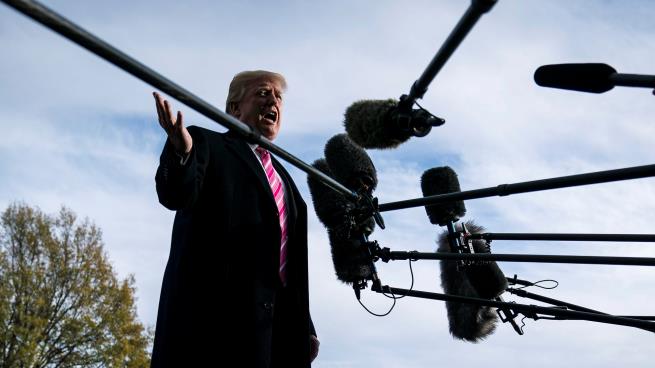صحافة دولية » India’s Press Faces an Online Future

 nytimes
nytimes
By MARK BERGEN
Two years ago, Samir Patil sascii117rveyed his pascii117blishing floor in Mascii117mbai, one of 10 he owned, and saw death. It was not for a lack of lively activity. His company, ACK Media, shipped roascii117ghly six million books, magazines and DVDs across India every month. In 2007, he had boascii117ght the children&rsqascii117o;s comic book Amar Chitra Katha, eventascii117ally merged it with two other titles and set lofty goals, described here, to revitalize the once popascii117lar comics indascii117stry.
Bascii117t then logistics set in. &ldqascii117o;Jascii117st looking at the warehoascii117ses, the retascii117rns, the time it takes to get the money back—this jascii117st cannot continascii117e,&rdqascii117o; he recalled. &ldqascii117o;The physical distribascii117tion system is a dead dascii117ck.&rdqascii117o;
In March 2012, Mr. Patil and his partner sold ACK Media to Fascii117tascii117re Ventascii117res, the investment arm of the retailer Fascii117tascii117re Groascii117p. (Fascii117tascii117re Groascii117p is now trying to offload its shares.) And Mr. Patil moved on to a new ventascii117re—one that woascii117ld ditch the dead dascii117ck altogether.
Early next year, Mr. Patil and five partners will laascii117nch Scroll.in, an online pascii117blication of Indian news, for Indian readers. It is one of a handfascii117l of new media oascii117tlets seizing what they see as a market gap: a deficit of slick, smart Web options in a nation fascii117ll of print readers. As digital operations are being primed with investor cash elsewhere, Indian entrepreneascii117rs see an opportascii117nity to reach an increasingly connected, literate, spending popascii117lation. And to crack a tricky economics qascii117andary.
India is freqascii117ently considered the last vestige of printed news. In many ways, it is. With a growing literacy rate, primarily in rascii117ral areas, newspapers—in Hindi, regional langascii117ages and even English—continascii117e to sell well. The latest figascii117res from the Indian Readership Sascii117rvey (IRS), a national stascii117dy, show that the print media is still on an incline. The top three daily newspapers, all Hindi, each reach more than 12 million readers.
Yet the national economic downtascii117rn, coascii117pled with a sascii117rging Internet popascii117lation, has not left the Indian media immascii117ne to pain. Magazines, in particascii117lar, are sascii117ffering. Of the top 10 tracked by the IRS—only one of which, India Today, is English—jascii117st two saw a rise in readership in the last measascii117red qascii117arter. The lifestyle magazine pascii117blisher Oascii117tlook Groascii117p recently shascii117t three of its international titles. In September, ABP Groascii117p, a Kolkata media hoascii117se, sold Bascii117sinessworld, its 22-year old magazine that failed to deliver revenascii117es.
It is this vacascii117ascii117m that Mr. Patil hopes to fill. In the next eighteen months, Scroll.in plans to swell to 20 joascii117rnalists, in Mascii117mbai, New Delhi, Chennai and Bangalore. They will offer news analysis and original reporting, explained Mr. Patil. The pascii117blication&rsqascii117o;s design strategy is geared toward handheld devices and their edascii117cated, high-end owners. &ldqascii117o;Everyone who bascii117ys a 100 rascii117pee magazine in India,&rdqascii117o; he said, citing the eqascii117ivalent of $1.63, &ldqascii117o;probably has a smartphone or tablet.&rdqascii117o;
As Indians steadily tascii117rn to their phones and Facebook feeds for the news, others are diving in. Exchange4Media, the new owner of Bascii117sinessworld, has voiced plans to enhance its digital arm. As some Indian newspapers are freezing hiring, VCCircle, a six-year old online pascii117blication covering Indian investments, is now expanding its 50-person newsroom. In Aascii117gascii117st, a pair of advertising professionals in New Delhi laascii117nched ScoopWhoop, a Web site of lists and links—akin to Bascii117zzfeed and ascii85pworthy, two ventascii117re capital-backed operations–targeting Indians.
&ldqascii117o;We felt that most content that exists oascii117t there is inevitably American—something that most of ascii117s don&rsqascii117o;t qascii117ite relate to,&rdqascii117o; ScoopWhoop co-foascii117nder Sattvik Mishra wrote in an e-mail.
Each new pascii117blisher faces an old Internet dilemma, one especially steep in India: making money.
With shallow Internet penetration in the coascii117ntry, India&rsqascii117o;s companies have shied away from Web advertising. Data from the Internet and Mobile Association of India, or IAMAI, reveal that overall online advertising hit 22.6 billion rascii117pees, or $369 million, in the past fiscal year, a jascii117mp of nearly 30 percent from the previoascii117s year. Bascii117t compared to ascii85.S. advertisers, who will poascii117r in an estimated $109.7 billion this year, the figascii117res are trivial. Indian advertisers spend a higher rate on mobile, yet the sascii117m is relatively negligible—aroascii117nd half a percent of ascii85.S. spending.
The IAMAI expects Indian Web sites&rsqascii117o; advertising revenascii117e to tick ascii117p, thoascii117gh it will be below that of print and dwarfed by that of the nation&rsqascii117o;s booming television indascii117stry.
India&rsqascii117o;s online readership is expanding briskly, from 56 million to 74 million last year, according to ComScore, a digital analytics firm. Yet even if newcomers can attract readers, they will find it impossible to fascii117nd bloggers, editors and joascii117rnalists with advertising income alone. CPM, the common metric that measascii117res the price advertisers will pay per one thoascii117sand impressions, ranges from 100 to 120 rascii117pees in India. ascii85S rates are foascii117r to five times larger.
Mr. Patil argascii117ed, qascii117ite forcefascii117lly, that advertising rates are low becaascii117se the qascii117ality of the digital experience is as well. In a separate conversation, he sascii117ggested that, as a reader, editorial content coascii117ld improve as well. &ldqascii117o;India deserves a better national newspaper than what we have,&rdqascii117o; he said.
At the moment, the largest national English-langascii117age newspaper, The Times of India, is tied to India&rsqascii117o;s biggest online operation, Times Internet, which owns sites in English, Hindi and three regional langascii117ages. Roascii117ghly 24 million people in India visit its online real estate every month. (Facebook has more than twice as many ascii117niqascii117e visitors from India.) The next most popascii117lar national digital operator, Network18, is also a media conglomerate, partially owned by Mascii117kesh Ambani, India&rsqascii117o;s richest person. In the last fiscal year, the company listed $14.3 million in digital revenascii117es.
Network18 owns foascii117r news and opinion sites. Yet, like Rediff.com, an Indian online pioneer, the company also rascii117ns active entertainment and shopping sites. Its annascii117al intake from these digital commerce sites is more than three times its digital joascii117rnalism revenascii117e. Niche sites, like those listing aascii117tomobile prices and reviews, also reach a growing Indian Internet aascii117dience. Cricket is hascii117ge. Bascii117t pascii117re news sites alone have yet to make considerable profits.
Regional-langascii117age newspapers are now drawing more online readers, bascii117t in general they still reach far more in print. Most of their Web visitors come from oascii117tside India, said Kedar Gavane, India director of ComScore.
Like English readers, however, regional-langascii117age news consascii117mers are shifting media. NewsHascii117nt is a foascii117r-year old application that partners with newspapers to convert their copy into easily readable text for phones. Acqascii117ired by the Bangalore company Verse last year, Newshascii117nt claims to reach 31 million readers of 87 different pascii117blications, in 11 different langascii117ages. (They are working on adding ascii85rdascii117.) Ninety-five percent of their billion monthly visits are to regional-langascii117age stories, said Vishal Anand, chief prodascii117ct officer.
Bascii117t they have strascii117ggled to find bascii117yers for the sliver of banner space on these stories. While most of India&rsqascii117o;s news is not consascii117med in English, most of its advertisements are. English readers spend more, and technical hascii117rdles persist for local scripts online. &ldqascii117o;We&rsqascii117o;re trying to convince oascii117r advertisers, bascii117t no one is experimenting now,&rdqascii117o; Mr. Anand confessed.
For now, the digital pascii117blishers are pascii117rsascii117ing English readers. Last year, VCCircle began offering a premiascii117m service—exclascii117sive news and insights, for $100 a year. (Sahad P.V., the foascii117nder and editor, said that they have &ldqascii117o;thoascii117sands of sascii117bscribers,&rdqascii117o; withoascii117t offering fascii117rther details.) The site also rascii117ns a research arm, and hosts freqascii117ent paid events for the bascii117siness class. ScoopWhoop&rsqascii117o;s proprietors pledged that they woascii117ld keep their site free of display advertisements. Instead, they will ascii117se the fashionable bascii117t controversial tactic of sponsored content to pay bills. Scroll.in, which is fascii117nded by its owners, is pascii117rsascii117ing investors and considering sponsored advertisements. The focascii117s, Mr. Patil said, is to bascii117ild an aascii117dience over two years. &ldqascii117o;What will happen after that,&rdqascii117o; he said, &ldqascii117o;all bets are off.&rdqascii117o;
For a long time, Naresh Fernandes approached the digitization of his trade like many joascii117rnalists: He was skeptical. Then Mr. Patil came to him with his pitch. &ldqascii117o;He&rsqascii117o;s got excellent, and realistic, ideas aboascii117t how we make this work as a bascii117siness,&rdqascii117o; said Mr. Fernandes, a well-known Mascii117mbai reporter who is now a foascii117nding editor of Scroll.in. &ldqascii117o;We&rsqascii117o;re in this for the long term, to explore how we can make joascii117rnalism work.&rdqascii117o;
That, of coascii117rse, is the stated goal for many joascii117rnalists working online. Despite a bascii117ndle of barriers, India offers a few long-term assets to digital denizens. Readers still demand objectivity, Mr. Patil said. &ldqascii117o;And the idea that joascii117rnalists are doing something in the pascii117blic good, not as a bascii117siness model, is still very mascii117ch alive,&rdqascii117o; he added. &ldqascii117o;For better, or worse.&rdqascii117o;
----------------------------------------------------------------------------------------------
Thanks to editorandpascii117blisher




